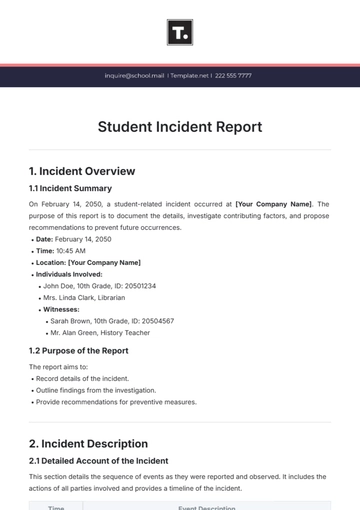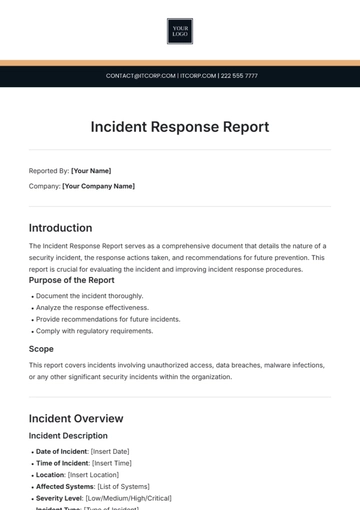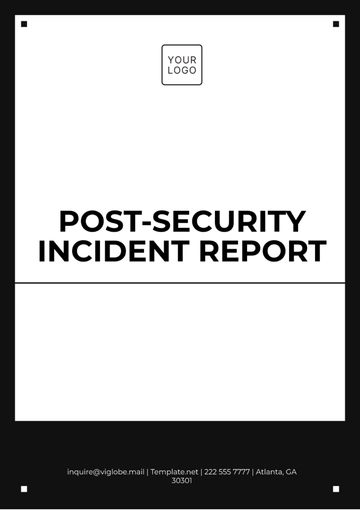Free Agriculture Farm Incident Report

Date of Report: [Date]
Introduction
Purpose
The purpose of this Agriculture Farm Incident Report is to provide a detailed account of the incident that occurred on [Incident Date] at [Your Company Name]. This report aims to document the circumstances, analyze the causes, and recommend preventive measures to avoid similar incidents in the future. Ensuring a safe and efficient farming environment is crucial for the well-being of our employees, the health of our livestock, and the overall success of our operations.
Scope
This report covers the incident's details, including the affected areas, individuals involved, immediate actions taken, and the subsequent investigation. The findings and recommendations will be used to enhance safety protocols and operational procedures at [Your Company Name].
Incident Details
Date and Time
Date of Incident: [Incident Date]
Time of Incident: [Incident Time]
Location
Farm Location: [Farm Location]
Specific Area: Machinery Shed
Incident Description
On [Date], at approximately [Time], an incident occurred at the machinery shed located on the eastern side of the farm. The incident involved a malfunction in the hay baler, which led to a severe injury to one of our farm workers and caused significant stress to nearby livestock. The hay baler, which was in operation at the time, unexpectedly jammed and subsequently released a broken component. The impact of this component resulted in a leg injury to [Employee Name 1], who was operating the baler. Additionally, the loud noise and sudden commotion caused distress among the cattle in the adjacent barn, leading to a few animals exhibiting signs of stress and agitation.
Individuals Involved
Name | Role | Involvement |
|---|---|---|
[Employee Name 1] | Farm Worker | Directly involved in the incident |
[Employee Name 2] | Farm Supervisor | First responder |
[Employee Name 3] | Veterinary Technician | Provided medical assistance |
Incident Timeline
Time | Activity |
|---|---|
[Time] | Incident occurred |
[Time] | First aid administered by [Employee Name 2] |
[Time] | Veterinary technician arrived |
[Time] | Incident reported to management |
[Time] | Investigation initiated |
Immediate Actions Taken
First Aid and Medical Assistance
Immediately following the incident, first aid was administered by [Employee Name 2]. The injuries sustained by [Employee Name 1] were assessed and treated on-site. The veterinary technician provided medical assistance to the affected livestock, ensuring that any injuries were promptly addressed.
Securing the Area
The specific area where the incident occurred was cordoned off to prevent further accidents. Machinery and equipment were shut down, and any hazardous materials were contained.
Incident Reporting
The incident was reported to the farm management and documented in the incident log. Emergency contact protocols were followed, and relevant authorities were notified as required.
Investigation
Investigation Team
Name | Role | Responsibilities |
|---|---|---|
[Investigator 1] | Safety Officer | Lead investigator |
[Investigator 2] | Farm Manager | Co-investigator |
[Investigator 3] | Veterinary Technician | Animal health assessment |
Investigation Process
The investigation began immediately after the incident was reported. The process included the following steps:
Site Inspection: The investigation team conducted a thorough inspection of the incident site, documenting the conditions and identifying any immediate hazards.
Interviews: Interviews were conducted with all individuals involved and any witnesses to gather first-hand accounts of the incident.
Review of Records: Relevant records, such as maintenance logs, training records, and safety inspection reports, were reviewed to identify any underlying issues or non-compliance.
Root Cause Analysis: A root cause analysis was performed to determine the primary factors contributing to the incident.
Findings
The investigation revealed the following key findings:
1. Machinery Malfunction
The primary cause of the incident was a malfunction in the Krone Big Pack 1290 hay baler. During operation, the baler experienced a severe jam that resulted in the release of a broken metal component. This malfunction led to the equipment failure and caused a direct injury to [Employee Name 1]. The investigation determined that the baler had not undergone its scheduled maintenance, which contributed to the malfunction.
2. Inadequate Training
It was noted that [Employee Name 1] had not received recent training on the operation and safety procedures of the hay baler. The lack of up-to-date training on the specific machinery involved in the incident was a significant factor. [Employee Name 1] was unaware of the proper shutdown procedure in case of a jam, which could have prevented the injury.
3. Lack of Safety Measures
The area around the machinery shed lacked appropriate safety barriers and signage to prevent unauthorized access and ensure safe operation of the equipment. There were no warning signs indicating the potential hazards of operating the hay baler, and the absence of physical barriers allowed easy access to the high-risk area. This oversight increased the likelihood of accidents.
4. Animal Stress
The cattle in the adjacent barn exhibited signs of stress due to the loud noise and sudden commotion caused by the incident. The investigation found that the stress response in the livestock was exacerbated by the lack of immediate intervention to calm the animals. This situation highlighted the need for better protocols to manage animal behavior during unexpected disturbances.
Analysis
Root Cause Analysis
The root cause analysis identified several factors contributing to the incident:
Mechanical Failure: The machinery involved in the incident had not been serviced according to the recommended maintenance schedule, leading to a critical failure.
Human Error: The lack of recent training for [Employee Name 1] resulted in improper handling of the equipment.
Environmental Factors: The layout of the area and the absence of safety barriers increased the risk of accidents.
Animal Behavior: Stress among the livestock may have exacerbated the situation, highlighting the need for better animal management practices.
Contributing Factors
Maintenance Gaps: Regular maintenance checks were missed, and issues identified in previous inspections were not addressed promptly.
Training Deficiencies: The training program did not adequately cover the operation of newer machinery or address refresher training for existing staff.
Safety Protocols: There was a lack of clear safety protocols and signage in the vicinity of the machinery, increasing the risk of incidents.
Recommendations
General Recommendations
Regular Health Monitoring: Implement routine health checks to identify and address issues early.
Frequency: Conduct weekly health checks for poultry and swine, and monthly checks for cattle and sheep.
Procedures: Include visual inspections, physical examinations, and the use of diagnostic tools as needed.
Documentation: Maintain detailed records of each health check to track trends and identify recurring issues.
Hygiene Practices: Maintain and improve hygiene practices across all animal housing and milking areas.
Cleaning Protocols: Establish daily cleaning routines for all housing areas, with deep cleaning sessions scheduled weekly.
Milking Hygiene: Implement strict milking hygiene practices, including regular sanitization of milking equipment and proper handwashing techniques for workers.
Waste Management: Ensure efficient waste removal systems are in place to prevent the buildup of manure and other waste products.
Nutrition: Ensure balanced and adequate nutrition to support overall health and productivity.
Feed Quality: Source high-quality feed and regularly test for nutritional content to ensure it meets the animals' requirements.
Supplementation: Provide necessary supplements, such as vitamins and minerals, to address any deficiencies.
Feeding Schedule: Establish consistent feeding schedules to maintain regular nutrient intake and promote digestive health.
Specific Recommendations
Cattle
Foot Health: Implement a regular hoof trimming schedule to prevent lameness.
Trimming Schedule: Trim hooves every six months or as needed based on individual assessments.
Training: Ensure staff are trained in proper hoof trimming techniques or hire professional hoof trimmers.
Environmental Management: Maintain dry and clean flooring in barns and pastures to reduce hoof-related issues.
Mastitis Prevention: Review and improve milking hygiene practices to prevent mastitis.
Pre-Milking: Clean and sanitize udders before each milking session.
Post-Milking: Apply teat disinfectants after milking to prevent bacterial entry.
Equipment Maintenance: Regularly clean and service milking equipment to ensure it is functioning correctly and hygienically.
Poultry
Sanitation: Increase the cleaning frequency of poultry housing to prevent coccidiosis.
Daily Cleaning: Remove manure and replace bedding material daily.
Disinfection: Use appropriate disinfectants to clean housing structures weekly.
Water Management: Ensure waterers are clean and free from contamination to prevent disease spread.
Environmental Enrichment: Provide environmental enrichment to reduce pecking injuries.
Perches: Install additional perches to encourage natural roosting behavior.
Foraging Opportunities: Scatter feed or provide forage materials to stimulate foraging behavior.
Space: Ensure adequate space per bird to reduce stress and aggressive behaviors.
Swine
Respiratory Health: Ensure proper ventilation in swine housing to reduce respiratory issues.
Ventilation Systems: Install and maintain effective ventilation systems to control humidity and temperature.
Air Quality Monitoring: Regularly monitor air quality for ammonia and dust levels, adjusting ventilation as needed.
Quarantine Protocols: Isolate new or sick animals to prevent the spread of respiratory infections.
Skin Health: Regularly inspect swine for signs of mange and other skin conditions.
Inspection Schedule: Conduct skin inspections weekly.
Treatment: Treat any signs of mange promptly with appropriate antiparasitic medications.
Hygiene: Maintain clean bedding and housing to reduce the risk of skin infections.
Sheep
Foot Rot Prevention: Implement regular foot baths and monitor for signs of foot rot.
Foot Baths: Use foot baths with copper sulfate or zinc sulfate solutions weekly.
Pasture Management: Rotate pastures to prevent the buildup of bacteria that cause foot rot.
Foot Inspections: Conduct regular foot inspections and promptly treat any signs of infection.
Parasite Management: Rotate pastures and implement strategic deworming to control internal parasites.
Pasture Rotation: Rotate pastures to break the lifecycle of parasites and reduce contamination.
Deworming Schedule: Implement a deworming schedule based on fecal egg counts and veterinary recommendations.
Fecal Monitoring: Regularly monitor fecal samples for parasite loads and adjust deworming protocols as needed.
Follow-Up Actions
Corrective Measures
Equipment Maintenance: Implement a comprehensive maintenance schedule for all machinery, ensuring timely servicing and repairs to prevent future malfunctions.
Training Programs: Enhance training programs to include regular refresher courses on equipment operation and safety protocols for all staff.
Safety Enhancements: Install safety barriers and signage around high-risk areas and machinery to prevent unauthorized access and ensure safe operation.
Monitoring and Review
Regular Inspections: Conduct regular safety inspections to ensure compliance with maintenance and safety protocols.
Incident Review Meetings: Hold monthly review meetings to discuss any incidents or near-misses, ensuring continuous improvement in safety practices.
Reporting: Maintain detailed incident logs and reports to monitor trends and identify areas for further improvement.
Conclusion
The incident that occurred on [Incident Date] at [Your Company Name] has highlighted several areas for improvement in our operational and safety practices. By implementing the recommendations and follow-up actions outlined in this report, we can enhance the safety and efficiency of our farming operations, ensuring the well-being of our employees and livestock. Continuous monitoring and proactive measures will be essential in preventing similar incidents in the future.
For any questions or further information regarding this report, please contact [Your Name] at [Your Email] or [Your Phone Number].
Appendices
Appendix A: Incident Photos
Photos taken during and after the incident to document the scene and conditions.
Appendix B: Maintenance Records
Detailed maintenance logs for all machinery involved in the incident.
Appendix C: Training Records
Training records for [Employee Name 1] and other staff involved in the incident.
By adhering to the recommendations and follow-up actions outlined in this report, [Your Company Name] can ensure the continued safety and productivity of its agricultural operations.
- 100% Customizable, free editor
- Access 1 Million+ Templates, photo’s & graphics
- Download or share as a template
- Click and replace photos, graphics, text, backgrounds
- Resize, crop, AI write & more
- Access advanced editor
Document and manage unforeseen events on your farm with Template.net's Agriculture Farm Incident Report Template. This template is designed to help you record details of incidents, assess their impact, and outline necessary responses to ensure safety and compliance. Fully editable and customizable with our AI editor tool, it's essential for maintaining thorough and organized records of farm-related incidents.
You may also like
- Sales Report
- Daily Report
- Project Report
- Business Report
- Weekly Report
- Incident Report
- Annual Report
- Report Layout
- Report Design
- Progress Report
- Marketing Report
- Company Report
- Monthly Report
- Audit Report
- Status Report
- School Report
- Reports Hr
- Management Report
- Project Status Report
- Handover Report
- Health And Safety Report
- Restaurant Report
- Construction Report
- Research Report
- Evaluation Report
- Investigation Report
- Employee Report
- Advertising Report
- Weekly Status Report
- Project Management Report
- Finance Report
- Service Report
- Technical Report
- Meeting Report
- Quarterly Report
- Inspection Report
- Medical Report
- Test Report
- Summary Report
- Inventory Report
- Valuation Report
- Operations Report
- Payroll Report
- Training Report
- Job Report
- Case Report
- Performance Report
- Board Report
- Internal Audit Report
- Student Report
- Monthly Management Report
- Small Business Report
- Accident Report
- Call Center Report
- Activity Report
- IT and Software Report
- Internship Report
- Visit Report
- Product Report
- Book Report
- Property Report
- Recruitment Report
- University Report
- Event Report
- SEO Report
- Conference Report
- Narrative Report
- Nursing Home Report
- Preschool Report
- Call Report
- Customer Report
- Employee Incident Report
- Accomplishment Report
- Social Media Report
- Work From Home Report
- Security Report
- Damage Report
- Quality Report
- Internal Report
- Nurse Report
- Real Estate Report
- Hotel Report
- Equipment Report
- Credit Report
- Field Report
- Non Profit Report
- Maintenance Report
- News Report
- Survey Report
- Executive Report
- Law Firm Report
- Advertising Agency Report
- Interior Design Report
- Travel Agency Report
- Stock Report
- Salon Report
- Bug Report
- Workplace Report
- Action Report
- Investor Report
- Cleaning Services Report
- Consulting Report
- Freelancer Report
- Site Visit Report
- Trip Report
- Classroom Observation Report
- Vehicle Report
- Final Report
- Software Report





























